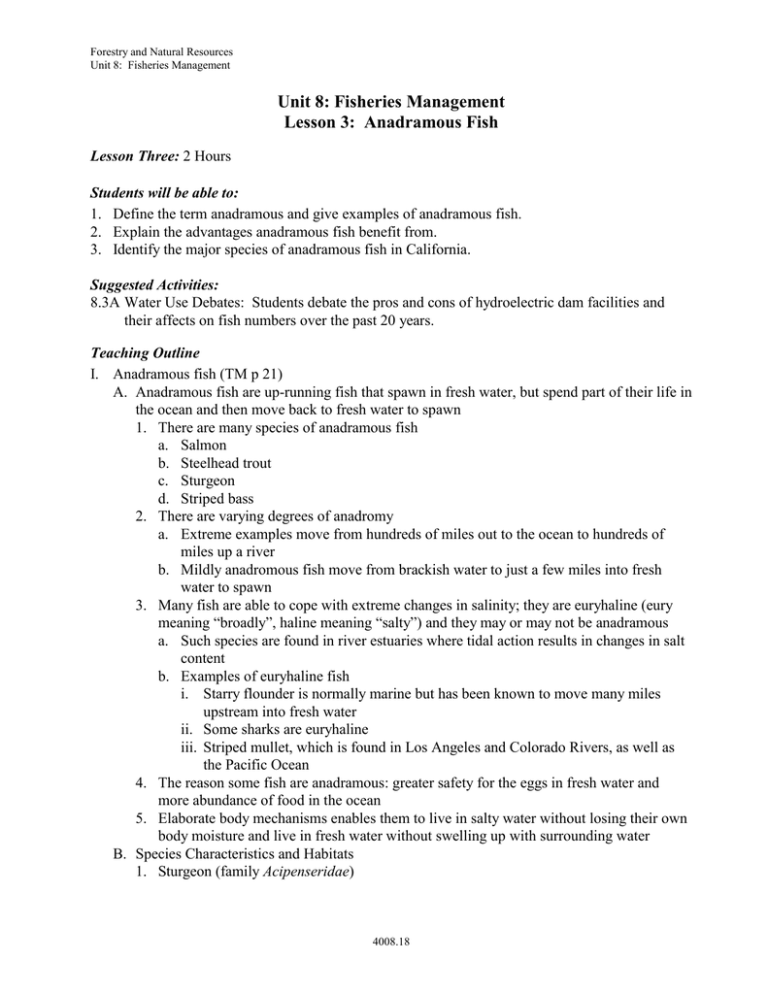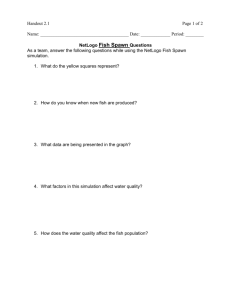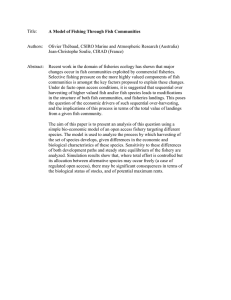Lesson 3 Anadramous Fish
advertisement

Forestry and Natural Resources Unit 8: Fisheries Management Unit 8: Fisheries Management Lesson 3: Anadramous Fish Lesson Three: 2 Hours Students will be able to: 1. Define the term anadramous and give examples of anadramous fish. 2. Explain the advantages anadramous fish benefit from. 3. Identify the major species of anadramous fish in California. Suggested Activities: 8.3A Water Use Debates: Students debate the pros and cons of hydroelectric dam facilities and their affects on fish numbers over the past 20 years. Teaching Outline I. Anadramous fish (TM p 21) A. Anadramous fish are up-running fish that spawn in fresh water, but spend part of their life in the ocean and then move back to fresh water to spawn 1. There are many species of anadramous fish a. Salmon b. Steelhead trout c. Sturgeon d. Striped bass 2. There are varying degrees of anadromy a. Extreme examples move from hundreds of miles out to the ocean to hundreds of miles up a river b. Mildly anadromous fish move from brackish water to just a few miles into fresh water to spawn 3. Many fish are able to cope with extreme changes in salinity; they are euryhaline (eury meaning “broadly”, haline meaning “salty”) and they may or may not be anadramous a. Such species are found in river estuaries where tidal action results in changes in salt content b. Examples of euryhaline fish i. Starry flounder is normally marine but has been known to move many miles upstream into fresh water ii. Some sharks are euryhaline iii. Striped mullet, which is found in Los Angeles and Colorado Rivers, as well as the Pacific Ocean 4. The reason some fish are anadramous: greater safety for the eggs in fresh water and more abundance of food in the ocean 5. Elaborate body mechanisms enables them to live in salty water without losing their own body moisture and live in fresh water without swelling up with surrounding water B. Species Characteristics and Habitats 1. Sturgeon (family Acipenseridae) 4008.18 Forestry and Natural Resources Unit 8: Fisheries Management a. All sturgeons are either anadramous or freshwater fish; they are the largest fresh water fish b. Sturgeon are slow growing and long lived i. A 118 years old, 18'10" long, 5300 lbs. (estimated) specimen has been recorded ii. Pacific Coast species reach about 350 lbs. iii. Legal size is at least 46” and no longer than 72” before you can keep them c. White sturgeon more common than the green sturgeon i. Body is long, cylindrical and has a gradual body taper to a thin caudal peducle ii. The tail is strongly heterocercal (the backbone extends into the much larger upper lobe) iii. Gray overall, but with some spots of paler gray d. Sturgeon have been found at sea from Ensenada to Alaska, but inland are generally found in rivers from Sacramento to San Francisco northward e. Feeding and food i. Feed close to the bottom ii. Barbels are sensitive to odor and taste iii. When food is detected the protrusile mouth drops down and sucks up the food iv. Crustaceans (shrimp, crawdads) make up the bulk of the diet, but small fish and clams are also eaten 2. Striped Bass (Roccus Saxatilis) a. Stripers are an atypical member of the Seabass family i. Seven or eight horizontal blackish stripes on the back and sides ii. Fish of 5-10 lbs. is typical north of Highway 140 in Merced County; keepers must be 18" long b. Found in the Sacramento and San Joaquin Rivers, the Delta, the California Aqueduct, and Delta Mendota Canal i. Small numbers have been taken on the Russian and Klamath Rivers ii. Found in some land locked lakes around Central California c. They feed on many forms of animal matter; crustaceans and fish make up the bulk of the diet 3. Salmon family (Salmonidae) a. There are three genera of this family found in California i. Trout - 4 true species ii. Chars - 3 true species iii. Salmon - 5 species b. Salmonids have many basic habits and requirements in common. All require cool or cold water; above 70 degrees F. is usually detrimental - 80 degrees F. can be fatal i. 58 degrees F. is about the upper temperature limit for egg survival ii. Eggs must be spawned in fresh water for survival iii. Only trout is the exclusive lake spawner iv. Eggs can only survive if buried in clean gravel v. After eggs are hatched and the yolk sack is absorbed species begin to differentiate vi. Food is animal material; they are opportunists and take anything that's available, including smaller fish of their own species 4008.19 Forestry and Natural Resources Unit 8: Fisheries Management c. Salmon - Pink, Sliver, King, Chum, Sockeye i. All strongly anadromous ii. All need same type of streams to spawn iii. Eggs hatch in 50 to 60 days; 3-4 weeks later fry emerge and become fingerlings iv. Spawning occurs October-January v. King Salmon are California’s most important commercial and sport fishing salmon 4008.20 Forestry and Natural Resources Unit 8: Fisheries Management 4008.21




